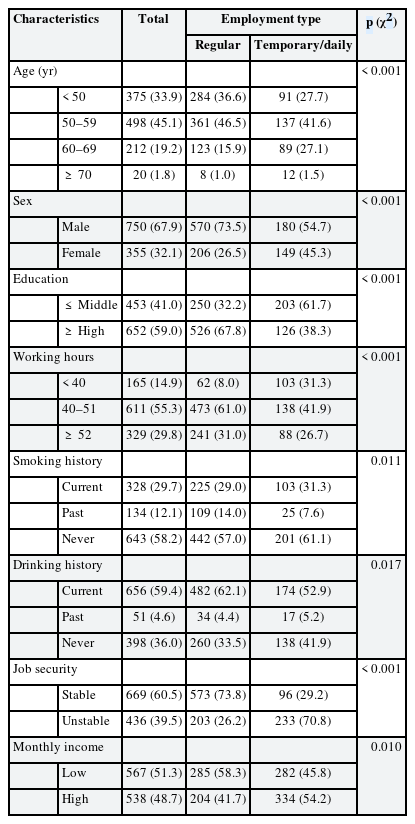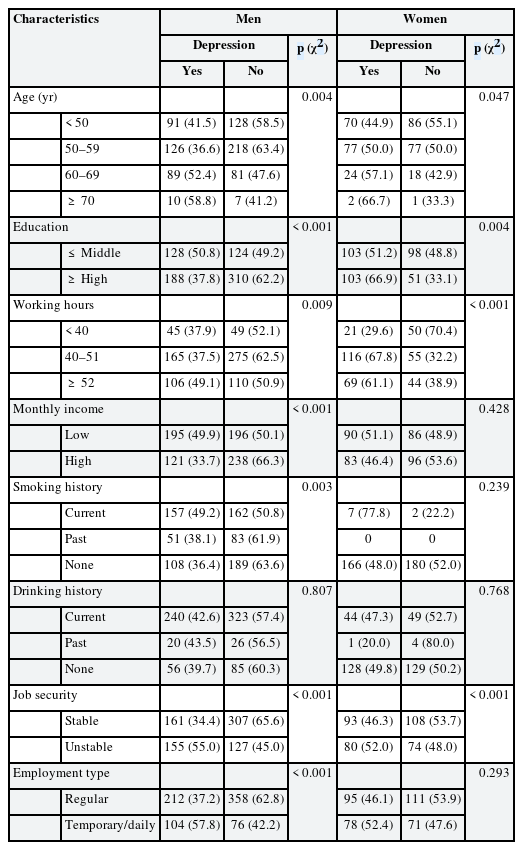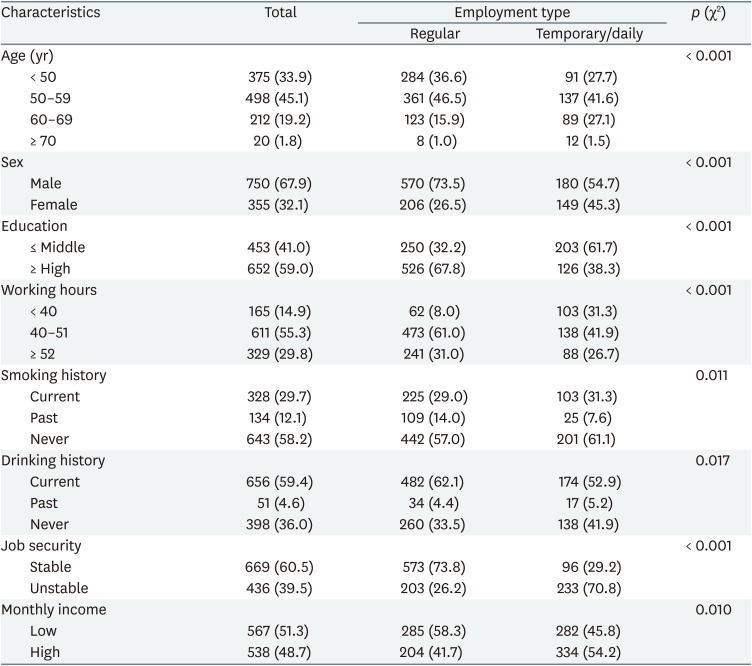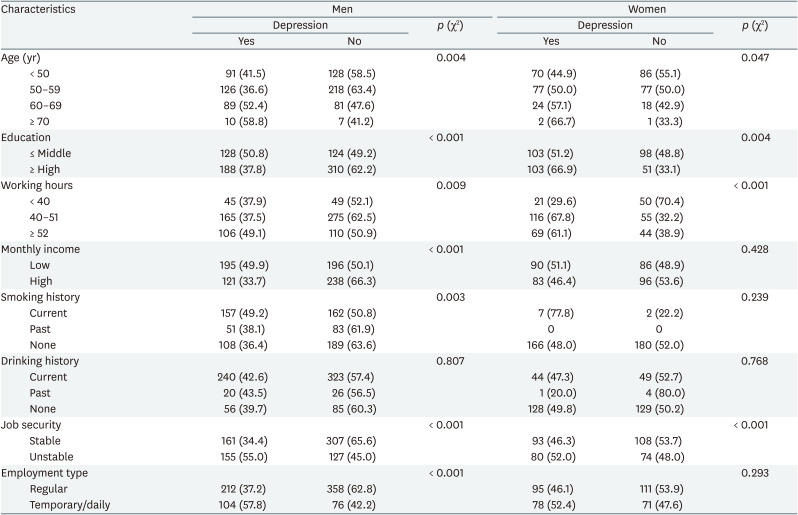The effect of job insecurity, employment type and monthly income on depressive symptom: analysis of Korean Longitudinal Study on Aging data
Article information
Abstract
Background
In modern society, depression is serious issue that causes socioeconomic and family burden. To decrease the incidence of depression, risk factors should be identified and managed. Among many risk factors for depression, this study examined socioeconomic risk factors for depression.
Methods
We utilized first (2006), second (2008), and third (2010)-wave data from the Korean Longitudinal Study of Aging (KLoSA). Depressive symptom was measured with the 10-item Center for Epidemiological Studies Depression Scale, Short Form (CES-D-10) in the survey in 2008 and 2010. Three risk factors including job security, employment type and monthly income were measured in the survey in 2006. The association between risk factors and depressive symptom was analyzed by Cox proportional-hazard model.
Results
We analyzed data from 1,105 workers and hazard ratios (HRs) for 3 risk factors were significant entirely. In addition, regular worker with high income group is the most vulnerable group of poor job insecurity on depression among male workers (HR: 1.73; 95% confidence interval [CI]: 1.07–2.81). Finally, HRs for 7 groups who had at least 1 risk factor had higher HRs compared to groups who had no risk factors after stratifying 3 risk factors. In the analysis, significantly vulnerable groups were total 5 groups and the group who had highest HR was temporary/daily workers with poor job security (HR: 2.51; 95% CI: 1.36–4.64). The results concerning women, regardless of job type, were non-significant.
Conclusions
This study presented one or more risk factors among poor job security, low income, temporary/daily employment type increase hazard for depressive symptom in 2 or 4 years after the exposure. These results inform policy to screen for and protect against the risk of depression in vulnerable groups.
BACKGROUND
Depression is a mood disorder that can cause considerable socioeconomic burden and familial strain.1 Many countries have executed screening programs to address depression; however the prevalence of depression has rapidly increased. In South Korea, the lifetime prevalence of major depressive disorder increased gradually from 5.6% in 2006 to 6.7% in 2011.2 The World Health Organization has warned that, among all diseases, depression will likely have the highest economic burden in 2030.1 In addition, those with depressive disorder have a 20-fold higher risk for suicide than risk of general population.3 Furthermore, the prevalence of depression in the elderly is higher than in the general population.4 Depression in the elderly is highly associated with cognitive impairment and dementia.5
Depression has various causes, especially disturbances of neurotransmitters in microscopically. In macroscopically, the risk factors of depression are known as environmental, genetic, and socioeconomic factors.6 In recent years, the socioeconomic risk factors of depression have been emphasized because of the coronavirus disease 2019 (COVID-19) crisis. According to International Labour Organization report, labor income loss was estimated at 3.7 trillion US dollar and 114 million workers lost their jobs in 2020.7 Thus, the risk increment of risk factors on depression, especially job security and monthly income that are related to the current socioeconomic problems should be analyzed. In addition, the various socioeconomic problems which were caused by the COVID-19 crisis closely resembled employment conditions in the economic crisis of 2006–2008.8 Therefore, analysis of the data which was conducted during the economic crisis is meaningful for handling the crisis. Furthermore, selection of vulnerable group who easily suffered from depression is needed to provide screening test.
Two articles suggested that socioeconomic status could increase one’s risk of depression,9 especially among the elderly.10 Numerous articles have also revealed the association between job insecurity and depression; that is, poor job security increased participants risk of depression by 1.58 times.11 However, a comprehensive analysis of the interaction between job insecurity and other socioeconomic risk factors on depression has not been conducted. It is meaningful for vulnerable groups that have much higher risks than generable population and needed to assess for depressive symptoms. We also aim to reveal additional effects of interaction of risk factors, compared to risk elevation of single factor. Hence, a well-designed comprehensive study is needed to clarify the interaction effect between monthly income, perceived job insecurity and employment type on depressive symptom.
Poor job security is a term that is located between the employment and unemployment. Current employee who had poor job security is threatened with the unemployment.12 On the other hand, temporary or daily work is a condition that period of the contract is less than 1 year, indicating the objective job security. The past research has revealed that job insecurity leads to decrease of job satisfaction only in regular workers and not in temporary workers and the results imply the difference of adverse effect of job insecurity between employment types.13 Thus, we included job insecurity and employment type as risk factors to analyze the interaction effect of variables.
This study used 4-year follow-up data from 1,105 participants to assess the risk of each group based on monthly income, perceived job insecurity and employment type. We controlled for variables such as age, sex, education level, working hours, smoking history, alcohol consumption history and job stress. We hope to provide scientific evidence that can be used to design policy for the early detection and prevention of depression for vulnerable groups.
METHODS
Study design and study population
We utilized first, second, and third-wave data from the Korean Longitudinal Study of Aging (KLoSA). The KLoSA is a prospective cohort study that collects information from adults (aged ≥ 45 years) including their health status, occupational history and status, educational background, income, and personal property. It is conducted by the Ministry of Labor of Korea every 2 years (since 2006) to establish and mediate welfare policy by analyzing the data. The data are publicly available (https://survey.keis.or.kr/klosa/klosa02.jsp).
One thousand regions were selected after stratification by geographical area and housing type, and 12–15 households in each region were randomly selected. In the first- (2006), second- (2008), and third-wave (2010) surveys, 10,254, 8,688, and 7,920 individuals participated in the KLoSA, respectively. The survey was performed through computer-assisted personal interviewing. The household response rate was 70.7%, and the individual response rate was 75.4%.
In this study, 1,855 participants who were regular, temporary, or daily employees were included. A total of 350 individuals who had a score ≥ 4 on the 10-item Center for Epidemiological Studies Depression Scale, Short Form(CES-D-10) in the first wave were excluded. Moreover, missing cases (n = 371) and participants who did not provide answers concerning monthly income (n = 27) were excluded; thus, we analyzed data from 1105 workers.
Measures
Depressive symptoms
The outcome variable was depressive symptoms, which were measured with the CES-D-10, a widely used screening test. The scores for the responses were as follows: “for a brief moment or never” and “sometimes” (0) and “frequently” and “always” (1). Scores thus range from 0 to 10, and 4 is the cut-off score that indicates probable depression.1415 In this study, CES-D-10 scores from 2008 and 2010 were used, and participants whose CES-D-10 score was ≥ 4 at least once in 2008 or 2010 were classified as the depression group. Thus, participants were divided into 2 groups: depression group (CES-D-10 score ≥ 4 at least once in 2008 or in 2010) and non-depression group (CES-D-10 score < 4 in 2008 and in 2010).
Employment type
The independent variables were employment type, monthly income, and job security. Employment type was assessed with the following question: “What type of employee are you?” Possible answers were regular worker, temporary worker, and daily worker. A regular worker was defined as a worker who had a work contract for at least 1 year and who could keep working if said contract did not exist. A temporary worker was defined as a worker who had a work contract for less than 1 year but more than 1 month and who could no longer work past the 1 year. A daily worker was defined as a worker who had a work contract for less than 1 month, was hired on a daily basis, or who had no specific workplace. In this study, temporary and daily workers were merged into 1 group. Thus, participants were divided into 2 groups: regular worker and temporary/daily worker.
Monthly income
Monthly income was assessed with the following question: “What is your average monthly income from your work?” Participants provided their average monthly income after excluding tax, national pension, medical insurance, and employment insurance deductions. The median monthly income was 1,800,000 won for men and 900,000 won for women. Participants were divided into 2 groups: low-income group (< 1,800,000 won/month for male and < 900,000 won for female) and high-income group (≥ 1,800,000 won for male and ≥ 900,000 won for female).
Job security
Job security was assessed with the following item: “My Job is stable.” Possible answers were definitely yes, almost yes, almost no, and definitely no. In this study, participants were divided into 2 groups: good job security group (definitely yes and almost yes) and poor job security (definitely no and almost no).
Covariates
Sociodemographic variables were included as covariates: age (< 50, 50–59, 60–69, and ≥ 70 years), sex (male or female), education (< high school, or ≥ high school). Occupational variables were also included: average weekly working time (< 40 hours, 40–52 hours, and ≥ 52 hours). In addition, smoking history (current smoker, past smoker, or never smoker) was included. Job stress was assessed by the following item: “I get a lot of stress during the working hours” and the possible answers were “Extremely yes,” “Yes,” “No,” and “Extremely no.” “Extremely yes” and “Yes” were classified as the high job stress group and “No” and “Extremely no” were classified as the low job stress group.
Statistical analysis
First, the frequencies of participants’ general characteristics (age, sex, education, weekly working hours, smoking history, job stress, and job security) were calculated in the subsamples by employment type; then, these were analyzed with χ2 tests. Second, the frequency of general characteristics was calculated in the subsamples by sex and CES-D-10 score (i.e., depression and non-depression groups), which were also analyzed with χ2 tests. Finally, hazard ratios (HRs) of group who have each risk factor that is low job security, temporary/daily employment type, low monthly income were calculated. Furthermore, analysis of effect of job security was conducted after stratifying employment type and monthly income. Also, we made 7 groups by job security, employment type and monthly income and the HRs of each group were analyzed. HRs and 95% confidence intervals (95% CIs) were calculated with a Cox proportional-hazard regression model after stratifying sex. Sociodemographic variables included age, sex,16 education level,17 health-related behavior included smoking,18 alcohol consumption history,19 weekly working time,20 and job stress,21 which revealed as important factors of depression were considered as confounder and adjusted in our model. In our analysis, participants who developed depressive symptom in 2008 were treated as censored at 2008, regardless of CES-D score in 2010.
Proportional hazards assumption was performed in this study with Schoenfeld residual test to confirm consistency of HR over observation time. None of covariates violated the assumption. To exclude the problem of multicollinearity, variance inflation factors (VIF) were calculated for all variables which used in each model. All the VIF values were smaller than 5, indicating that multicollinearity problem was not existed in this study. All analyses were performed using R software (version 3.6.2; R Foundation for Statistical Computing, Vienna, Austria) using ‘survival’ packages.
A sensitivity analyses with generalized linear mixed models were performed to check the robustness of results in this study. Using generalized linear mixed model, we estimated the cross-sectional association between repeated measured depressive symptoms among participants and main variables. The result for sensitivity analyses were presented in Supplementary Tables 1, 2, 3, 4.
Ethics statement
The present study protocol was reviewed and approved by the Institutional Review Board of Severance Hospital (approval number: 4-2022-0509).
RESULTS
Table 1 shows participants’ demographic and job-related characteristics according to job type. Those who were older (vs. younger), men (vs. women), and more educated (vs. less) were significantly more likely to be regular workers. Regular workers were significantly more likely to be current smokers than temporary/daily workers. Finally, regular workers had significantly higher job security than did temporary/daily workers.
Table 2 presents the prevalence of depressive symptom in each group. There were 489 cases (44.3%) of depressive symptom during the study period. Female (vs. male) workers were significantly more likely to be depressed. Those who were aged ≥ 70 years were significantly more likely to be depressed than their younger counterparts, regardless of sex. In men, the incidence rate of depressive symptom significantly decreased as education level increased. In both sexes, the incidence rate of depressive symptom significantly increased as working hours increased and when job security was unstable. Lastly, in both sexes, the temporary/daily worker group had a significantly higher incidence rate than did the regular worker group.
Table 3 presents the association between depressive symptom and job security and job type using a Cox proportional-hazard regression analysis. Concerning poor job security, the HRs (95% CIs) of depressive symptom were 1.67 (1.32–2.11) in men and 1.09 (0.80–1.49) in women after adjusting for age, education, working hours, drinking status, and smoking status. Concerning income, the HRs (95% CI) of depressive symptom were 1.40 (1.07–1.83) in men and 1.08 (0.78–1.51) in women. Concerning job type, the HRs (95% CI) of depressive symptom were 1.74 (1.33–2.27) in men and 1.21 (0.88–1.66) in women.
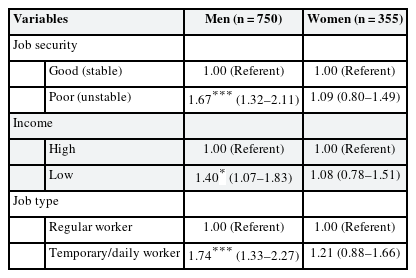
The association between depressive symptom and job security and job type by Cox proportional-hazard regression analysis
Table 4 showed the effect of job security on male workers after stratifying employment type and income. We divided male worker into 4 groups as Regular workers with high income and low income, Temporary/daily workers with high income and low income. Good job security group is selected as referent group for each group, and we obtained HRs that showed the effect of job security. Only 1 group showed significant difference between good job security group and poor job security. Among regular male workers with high income, poor job security group had higher hazard than referent group (HR: 1.73; 95% CI: 1.07–2.81). Also, this group had the highest HR than the others.

The effect of job security on male workers after stratifying employment type and income on depressive symptom among the study sample
Table 5 presents the association using Cox proportional-hazard regression analyses. We further stratified the groups according to sex; then, we analyzed the effect of income, job security and employment type among groups. We set regular worker who have good job security and high income as a referent group.
First of all, we analyzed the effect of 3 risk factors in man regular worker group. Poor job security with high income group (HR: 1.66; 95% CI: 1.05–2.61) had a significantly higher hazard of depressive symptom compared to referent group.
Furthermore, poor job security with low income group (HR: 1.76; 95% CI: 1.19–2.61) had significantly a higher hazard of depressive symptom than referent group. Compared to 2 groups, a HR of depressive symptom was not significantly in good job security with low income group (HR: 1.28; 95% CI: 0.88–1.86).
Secondly, we analyzed the effect of 3 risk factors in male temporary/daily group. Good job security with low-income group (HR: 1.81; 95% CI: 1.02–3.22) had a significantly higher hazard of depressive symptom compared to referent group. In addition, poor job security with high income group (HR: 2.51; 95% CI: 1.36–4.64) had the highest hazard of depressive symptom among all combinations. Poor job security with low income group (HR: 2.27; 95% CI: 1.57–3.27) had significantly a higher hazard of depressive symptom than referent group. The results concerning women, regardless of job type, were non-significant.
In addition, we analyzed the demographic characteristics among the exclusion group who had depressive symptom in 2006 to confirm that the selection bias was negligible. According to Supplementary Table 1, all the characteristics did not have significant association with depressive symptom among male workers who were in exclusion group. In the case of female workers, age and education level were the only covariates that had significant association with depressive symptom.
Finally, in the sensitivity analysis, the same association was derived compared to the result by Cox proportional-hazard regression model. According to Supplementary Tables 2 and 4, additional significant result in female was found while the result showed no significant HRs in female. The difference might be caused by increment of analysis number in Generalized linear mix model.
DISCUSSION
The association between depressive symptom and 3 risk factors, especially job security was analyzed after stratification by sex using data from KLoSA. In this study, we showed that among male workers, job insecurity, low income and temporary/daily employment type were risk factors for depressive symptom. HRs for 3 risk factors were significant entirely. Several studies indicate the relationship between poor job security and depressive symptom. One study demonstrates that the job insecurity effects on the severe depressive symptoms after 5 years among male workers.22 Also, one meta-analysis demonstrates that poor job security is significant risk factor for depression 2 years, 3–4 years, over 4 years after the exposure.23 We also proved exposure to poor job security as a risk factor for depressive symptom after the exposure. The result in this study showed male workers who had exposed to poor job security were vulnerable to develop of depressive symptom after 2 or 4 years of exposure.
In this study, temporary/daily employment type increased risk for depression after 2 or 4 years of exposure which was consistent to the previous study. Quesnel-Vallée et al.24 also revealed that temporary work experience in the preceding 2 years is associated with elevation of depression symptom score in United States. However, they present non-significant relationship between temporary work and depressive symptom after 2–4 years.24 We showed that the long-lasting effects for 4 years of temporary/daily work on depressive symptom.
Furthermore, the past research has showed that workers whose income is less than $19,999 have higher hazard for depression in 3 years after exposure than workers with income of more than $70,000.25 The result was consistent to our study which use lag time of 2 and 4 years. In addition, higher income is associated with decreasing of psychological distress and psychological distress may influence the occurrence of depressive symptoms.26
In fact, average period of service of regular workers is 8 years compared to 2 years and 4 months of temporary/daily workers in Korea according to National Statistics Office in 2020.27 Temporary worker had to be concern about unemployment and make effort to apply for another position and this process may act as a mental stress that effect on depressive symptoms.
In addition, risk increment for depressive symptom was the highest in regular worker with high income after stratifying income and employment type among male workers. Regular worker with high income had HR of 1.73 which was the highest and the only significant among 4 groups in Table 4. The results suggested poor job security was critical risk factor of depressive symptom in workers who had good occupational conditions.
According to Table 4, poor job security decreased the risk of depressive symptom in temporary/daily workers with high income, although the HR was not significant. According to previous study, the mental health of workers who had worked in unfavorable working conditions improved in the year of becoming unemployed.28 In the same context, workers who had poor job security in the condition of unfavorable working condition may show lower risk for depression because of the expectation of change or termination of stressful experience. Also, considering the very small size of the group (temporary/daily workers with high income; n = 28), the result should be interpreted with caution.
Further, we posited that the group who had more risk factors have higher risk for depressive symptom except groups who had nonsignificant HRs. In Table 5, group who contained only 1 risk factor had HR of 1.66 and groups who contained 2 risk factors had HRs of 1.76, 1.81, and 2.51. Group who had 3 risk factors had HR of 2.27. One exception group that did not accept the proposition was group who had poor job security, Temporary/daily employment type and high income. This group had HR of 2.51 that was higher than HR of group who had all risk factors. It indicated high income group had factors that increase risk for depressive symptoms in temporary/daily workers with poor job security. High income group tended to be in charge of more difficult tasks than previously compared to low-income group. (34.8% vs. 13.4%) Physical and mental strain to deal with their assigned tasks would act as a stressor and risk factor for depressive symptom and this occupational condition made the paradoxical results in this analysis.
Poor job security is inner experience that is not realized and is differed from external experience such as receiving income and working in their current job. Thus, these perceived risks for job loss effect on the employee to be more uncertain for anticipate their future, because the job is closely connected with social and financial status in the modern society.29 For this reason, the effect of poor job security is comparable with it of job loss,30 and produces heavier burden and more critical factor of anxiety.31 Also, social and financial damage from the job loss is higher in the group who had greater occupational conditions such as high income and regular employment type than the counterparts. This theory could explain that poor job security is more important risk factor than low income or temporary/daily employment type. The theory could also explain risk increment for depressive symptom is the highest in regular worker with high income group.
This study did not find the significant relationship between job insecurity and depressive symptom in female workers. Various studies showed that the sex difference in prevalence, risk factor, pathophysiology of depression. The reason for sex stratification in the analysis is that the extent that the low job insecurity affect depression is differ across the sex.32 However, risk factors for depression in female include low job security were not significant and the female had lower HRs than male. The sex difference was expected to be caused by the proportion of monthly income to the total household income. Consistent with result of sex difference, previous studies have reported that precarious employment has no significant association with suicidal ideation and severe psychological distress in female workers.3334 Furthermore, Jang et al.35 have found that transition from non-precarious to precarious work is associated with development of depressive symptom in only breadwinners who are head of household. Considering the most of main earners were male in East Asia, the sex difference in this study was explained by difference of psychological burden from resignation in the future. Other study for clarifying the relationship between depression and job insecurity after stratified by sex and main earner is needed.
According to this study, regular check-ups for workers who have one or more risk factors in this study were needed to screen depressive symptom. Currently, Patient Health Questionnaire-9, tool for screening depressive symptom is included every ten years in national health screening program. Workers who are age of 20, 30, 40, 50, 60, 70 take screening for depressive symptom. In this study, workers who have one or more risk factors have higher HRs for depressive symptom in 2 or 4 years after exposure of risk factors. Thus, interval for screening test for high-risk groups should be shortened to 2 years to early detection and proper management. Secondly, question for perceived job insecurity should be included in regular check-up. To sum up, we suggested that the biennial screening test for depressive symptom is needed for workers who have more than 1 risk factor among poor job security, temporary/daily employment type and low monthly income.
This study had some limitations. We did not consider participants’ job changes or unemployment. A previous study showed that transitions in job security status are not significantly associated with depression, and chronic job insecurity is an important factor for depression.36 Moreover, there was a policy change concerning temporary/daily workers between the first and second waves of the KLoSA; specifically, fixed-term and part-time employees were better protected against discrimination and unfavorable treatment than they were before. Moreover, a law was passed to encourage employers to hire part-time employees if they are unable to recruit regular employees. After this law was established in 2007, the level of perceived job insecurity likely changed, which may have affected our analysis.
The strength of this study is that it was the first study that examined the difference of several risk factors for depressive symptom after stratifying by employment type and income in South Korea. In this study, we showed that job security is more important risk factor than other risk factors for depressive symptom.
CONCLUSIONS
In conclusion, the association between workers’ job insecurity, temporary/daily employment type, low monthly income and depressive symptom is clear. Also, groups who have more risk factors trend to have higher HRs. Finally, the most vulnerable group for job insecurity is regular workers with high income. These results can inform policy to screen for and protect against the risk of depressive symptom in vulnerable groups. Furthermore, adequate economic and psychological support for those who have job instability should be essential when the society face an economic crisis.
ACKNOWLEDGEMENTS
The authors thank to all of the participants and working groups at Korean employment information service of Korean Longitudinal Study of Aging (KLoSA).
Notes
Funding: This study was supported under the framework of international cooperation program managed by the National Research Foundation of Korea (FY2021) (NRF-2021K2A9A1A01102239).
Competing interests: The authors declare that they have no competing interests.
Author Contributions:
Conceptualization: Lim MH, Yoon JH.
Data curation: Lim MH.
Formal analysis: Lim MH, Yoon JH.
Investigation: Lim MH, Lee WT, Kim MS, Baek SU.
Methodology: Lim MH, Yoon JH.
Supervision: Yoon JH, Won JU.
Visualization: Lim MH.
Writing - original draft: Lim MH.
Writing - review & editing: Lim MH, Yoon JH, Won JU, Lee WT, Kim MS, Baek SU.
Abbreviations
CES-D-10
10-item Center for Epidemiological Studies Depression Scale, Short Form
CI
confidence interval
COVID-19
coronavirus disease 2019
HR
hazard ratio
KLoSA
Korean Longitudinal Study of Aging
VIF
variance inflation factors
References
SUPPLEMENTARY MATERIALS
Supplementary Table 1
Prevalence of depressive symptom among the exception group who had depressive symptom at the baseline
Supplementary Table 2
The association between depressive symptom and job security and job type by generalized linear mixed model
Supplementary Table 3
The effect of job security on male workers after stratifying employment type and income on depressive symptom among the study sample by generalized linear mixed model
Supplementary Table 4
The effect of job security, income and employment type on male and female workers by generalized linear mixed model

